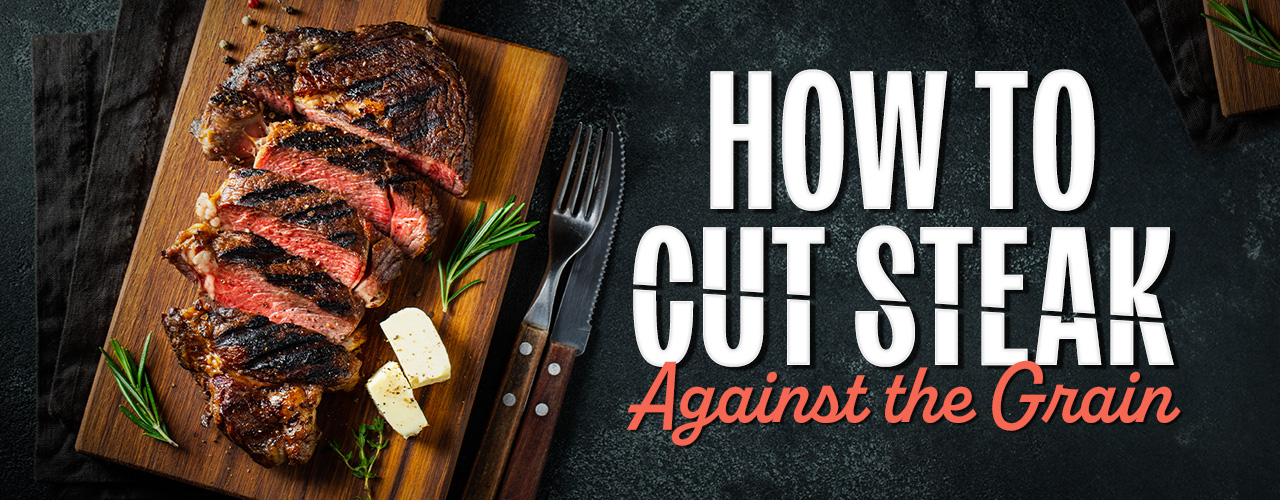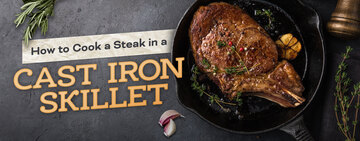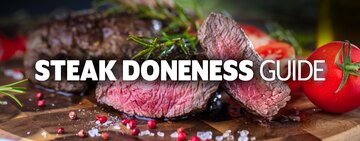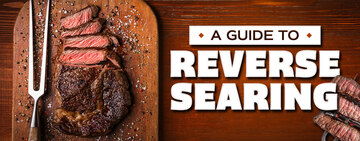The grain on steak refers to the direction of the muscle fibers in the meat. It can often be seen as lines or striations running along the surface of the cut. Slicing steaks against, or perpendicular, to the grain preserves its tender bite while slicing steak with the grain can ruin a perfectly cooked steak, rendering it tough and chewy. Identifying the grain can take a bit of practice, especially with naturally tender steak cuts where the fibers may be less visible, but it’s a valuable skill for achieving the best texture in your steaks. We’ll go over how to identify and cut against the grain so you can be sure you’re serving the most flavorful, juicy steak.
Why Cutting Steak Against the Grain Matters

Whether you operate a carving station or are slicing steak for salads, pasta dishes, sandwiches, or tacos, training your food handlers to cut steak against the grain is crucial. This technique isn't just about presentation – it plays a significant role in the overall dining experience. Here are the three ways slicing against the grain affects meat:
- Tenderness: Cutting against the grain shortens the muscle fibers, which makes the meat more tender and easier to chew. On the other hand, slicing with the grain preserves the long muscle fibers, creating more work for the teeth to break down and resulting in a tougher, chewier bite.
- Flavor: Steak retains more of its natural juices and flavors when sliced against the grain. Just be sure to let it properly rest before slicing so that the juices can reabsorb and redistribute.
- Presentation: Simply put, properly sliced meat looks more appealing on the plate. This is especially important for caterers and buffets offering carving stations on the menu.
How to Find the Grain
Now that you know why you need to cut across the grain, how exactly do you find it? Visual cues play a vital role in determining the direction of the grain. Look closely at the surface of the steak – you'll notice long, parallel lines or striations running across the meat. These lines represent the muscle fibers of the meat. By following these lines, you can easily identify the grain's direction.
Tougher cuts of meat, like flank and skirt steak, feature long muscle fibers that run uniformly along their length, making them easier to identify compared to steaks sourced from less-worked muscles on the cow, such as filet mignon and ribeye. These tougher cuts are particularly crucial for slicing against the grain. Although it’s important to slice all steak cuts across the grain, the steak cuts with little or no connective tissue are more forgiving if you happen to cut with the grain, as their inherent tenderness makes them easier to chew.
Keep in mind that the grain isn't always consistent in every cut of steak. For instance, cuts like Tri-tip and Porterhouse have at least two distinct grain directions due to their unique muscle structure. In such cases, take extra care to identify both grain patterns before making your cuts to ensure you're slicing against each one correctly.
How to Cut Steak Against the Grain

How you prepare a steak is significant in determining its flavor, but it's not the only factor. How you cut it and what you use to slice it all contribute to achieving the perfect steak. Follow these steps for slicing steak against the grain to guarantee maximum tenderness:
- Place the meat on a cutting board. Position the meat so that the grain runs with the length of the cutting board. This will make it easier for you to make perpendicular cuts. Use a stable, non-slip cutting board to ensure safety.
- Identify the grain. Observe the direction of the muscle fibers. The “grain” refers to the alignment of these fibers. If the meat has multiple sections with different grain directions, note these areas before cutting.
- Cut perpendicular to the grain. Using a sharp chef’s or carving knife, start at one end of the meat and slice through the grain. If the meat has different grain directions, cut each section separately and reposition so the new grain direction is parallel to the length of the cutting board.
Tips for Cutting Against the Grain
Here are some tips to keep in mind when slicing against the grain:
- Find the grain before cooking. The grain is much easier to find on an uncooked steak versus a cooked one. However, it's best to wait until the steak is cooked and properly rested before slicing into it to preserve its moisture and flavor. Making a note of the grain before cooking will ensure you don't make a mistake when it comes time to slice.
- Slice on a bias. This technique involves cutting the meat at a 45-degree angle rather than straight down. Slicing on a bias increases the surface area of each piece and enhances tenderness.
- Cut thin slices. Depending on the dish, aim for about 1/4 inch thick slices or thinner for more tender bites.
Cuts that Benefit from Slicing Against the Grain
As we've mentioned, all steak cuts benefit from slicing against their grain, but for some, it means the difference between a juicy, tender steak or a tough, leathery disappointment. Steaks sourced from the beef cuts of hard-working muscles contain a lot of connective tissue and have a lower fat content, so it is critical to break down their muscle fibers before serving. Flank steak, skirt steak, hanger steak, brisket, chuck roast, and top round steak are popular cuts that benefit from this technique. Their long, coarse muscle fibers are easy to track, so luckily slicing against the grain is a fairly easy task. Pork loin, venison, and other game meats can also benefit from being cut against the grain. Their fine grain can become tough if sliced incorrectly, so this technique helps maintain tenderness.
When it comes to slicing steak against the grain, the advantages are undeniable. By cutting perpendicular to the muscle fibers, you effectively break down tough connective tissues, resulting in each bite being more tender and flavorful. Tough cuts of meat particularly benefit from this simple yet powerful technique, as it enhances their texture and elevates the overall dining experience.








